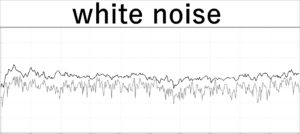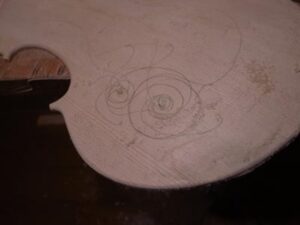Similarities between oriental medicine and violin making
We have seen that when scraping the resonance plate of an instrument, the phonogram inside the outline is automatically aligned when the outline sounds are matched. (Refer to “Sounds and Shapes of Ancient Musical Instruments”)
Of course, we will also carve the inside to make it the final shape. The resulting resonance plates are pasted together to form a box shape.

When it becomes a box, the one-dimensional boundary (outline) becomes the two-dimensional boundary (membrane). If we align the one-dimensional frame, we have a fixed point of phonogram in the center, but if we align all the sounds of the two-dimensional membrane, where is the fixed point? There will be a fixed point of phonogram in an empty space.
It sounds a little strange, but I don’t think you can answer “here” when asked “Where is your body’s center of gravity?” This is because the center of gravity can be the equilibrium point of the delicate balance of the whole.
A fixed point of phonogram appears when we actually play an instrument. Keep in mind that fixed points of phonogram are created when you exercise.
Aligning all the sounds of the resonance plate of an instrument is the same as aligning all the surface tensions of the instrument. If the acoustic symmetry is high, when energy is applied to the resonance plate, the energy is equally transmitted to the resonance plate. It may be said that we prepare a space (musical instrument) that can efficiently convert the kinetic energy (friction energy) of the strings into sound.
We have also seen that humans are moving musical instruments. (Refer to “Correlation between mind and body”)
Human skin is a two-dimensional membrane.
If this skin membrane is continuously deformed without making holes, it becomes the same as a balloon. If we think of a violin as a box, it is the same as a balloon (ignore the f-hole here).
In “Shape and Sound of Ancient Instruments”, we have seen that the internal phonogram is automatically adjusted by matching the boundary sounds. Based on this, if we raise it one dimension, it can be said that “when we match the sound (tension) on the surface of the membrane, the phonogram inside the membrane is automatically adjusted.” That’s true, but it’s also strange.
The inside of the skin membrane can be adjusted by keeping the tension on the surface of the skin constant. The ancients would have noticed this. The reason why acupuncture needles in the dermis can heal diseases and injuries is because it can keep the tension of the skin constant, not because of the idea of stimulating the nerves. When the skin tension becomes constant, the fixed points of phonogram become one, and Dantian is formed and the whole body becomes integrated. Moxibustion and massage also aim to create a local tension gap and regulate skin tension. If the sounds on the surface of the skin are aligned, a fixed point of phonogram will be created in the center, just like a musical instrument. This position is just below the navel. This is the so-called “Dantian”.
There is often an explanation that the meridians are autonomic nerves, but as explained earlier in the center of gravity of the body, it refers to the equilibrium point or line of balance. So it’s still correct to say that there is no such thing.
If the equilibrium point of balance is in the center of the body, the body is comfortable, but if it is far from the center of the body, this is a painful condition. Even if we look the same when viewed from the outside, we may be in a handstand state in the sense of the inside. This is actually the cause of pain that people feels. Also, if there are fixed points of phonogram all over the body, this can also be a pain. For example, when the self-consciousness is working too much or when the body feels stiffness inside.
When we study musical instruments and the body with phonogram, it is basically the study of membranes. This is a study to control the internal situation by changing the tension of the membrane. The internal state changes dynamically with only a small change. The phonogram of an instrument does not change unless you make changes, but the phonogram is constantly changing due to the flow of heat in the body. As the temperature changes, so does the string tension (membrane tension). As the string tension changes, so does the sound. And these physical quantities are in function relations.
- カテゴリー
- BLOG


